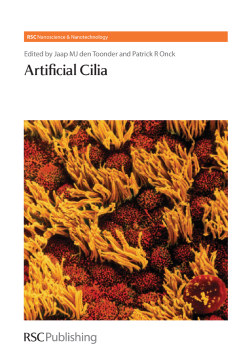
Additional Information
Book Details
Abstract
Cilia are tiny hairs covering biological cells to generate and sense fluid flow. Millions of years of evolution have inspired a novel technology which is barely a decade old. Artificial cilia have been developed to control and sense fluid flow in microscopic systems, presenting new and interesting options for flow control in lab-on-a-chip devices.
This appealing link between nature and technology has seen rapid development in the last few years, and this book presents a review of the state-of-the-art in the form of a professional reference book.
The editors have pioneered the field, having initiated a major European project on this topic soon after its inception. Active researchers in academia and industry will benefit from the comprehensive nature of this book, while postgraduates and those new to the field will gain a clear understanding of the theory, techniques and applications of artificial cilia.
Jaap den Toonder gained his PhD at the Delft University of Technology a PhD degree in 1996 on a numerical/theoretical and experimental study of drag reduction in turbulent flows by polymer additives. A year prior to this he joined the Philips Research Laboratories in Eindhoven, The Netherlands, where he started working in the field of the mechanics of solid materials. He has worked on a wide variety of applications, such as ceramic capacitors, optical storage systems, IC low-k materials, RF MEMS, soft electronics, biomedical devices, polymer MEMS, and micro-fluidics. In 2008, he made the move to Philips Applied Technologies where, as Chief Technologist, he leads the R&D program on (micro-) fluidics. He is involved in research programs on molecular diagnostics, lab-on-chip, immersion lithography, and energy applications. Since 2004, Jaap den Toonder combines his work at Philips with a part-time professorship at the Materials Technology group of the University of Technology of Eindhoven (TU/e). Jaap has co-authored more than 50 scientific papers and over 40 patent applications. He currently serves on the editorial board of Lab-on-a-Chip.
Patrick Onck obtained a PhD in applied mathematics from Delft University of Technology in 1998, and followed this with more than a year of postdoctoral research at Harvard University. Between 1998 and 2003 he held a fellowship from the Netherlands Academy of Arts and Sciences. Since 2001 Patrick has worked at the University of Groningen, where he is currently associate professor in applied physics. His current research interests include cell biophysics and microfluidics, incorporating several research themes around artificial cilia. His publication record lists more than 100 scientific articles authored and the co-editorship of three book volumes.
